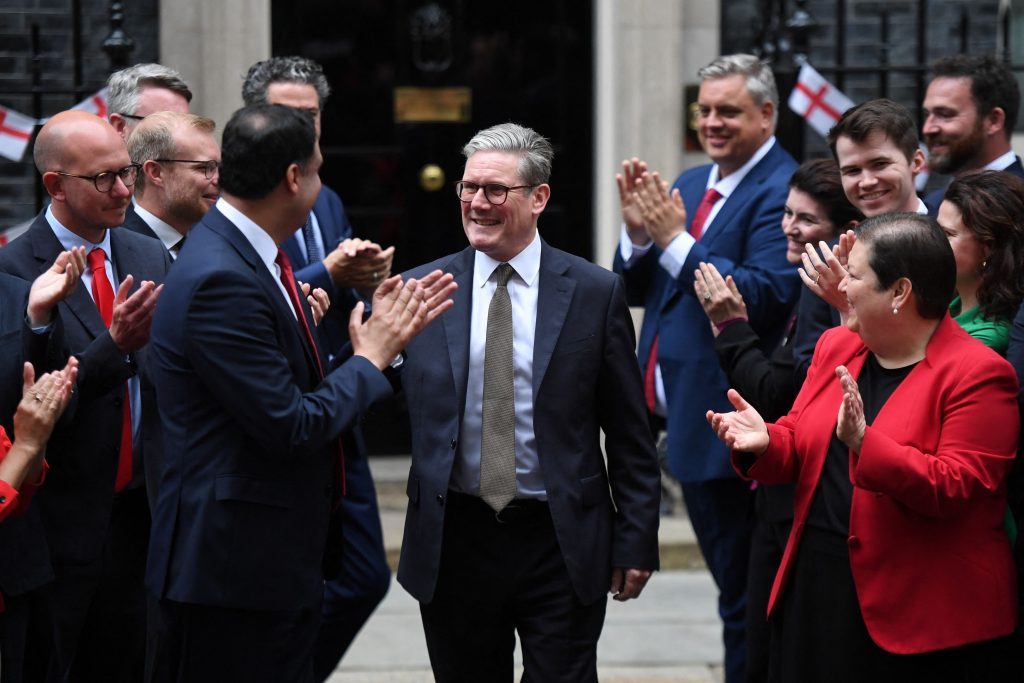New governments in Europe are being handed a poisoned chalice. They are being elected with mandates for change, but only limited means at their disposal to enact it.
Public debt is close to multidecade highs on both sides of the English Channel, where voters this week were electing new parliaments. In both France and the U.K., government spending and budget deficits as a share of gross domestic product are significantly above prepandemic levels. Economic growth remains lackluster, borrowing costs have surged, and demands on the public purse are rising, from defense to old-age pensions.
All that means fiscal restraint—less spending or higher taxes—will be necessary, economists say. But politicians haven’t prepared electorates for that. On the contrary, they have signaled bold new spending plans.
In France, the far-right National Rally, which exit polls suggested would emerge as the third biggest bloc in parliament in Sunday’s election, has proposed sweeping tax cuts and reversing President Emmanuel Macron ’s unpopular increase in the state pension age, although party officials recently walked back some of those promises. The New Popular Front, a left-wing alliance that exit polls suggested would emerge with the most seats, has an even more ambitious agenda. It includes price freezes and a large increase in the minimum wage that would require higher subsidies and salaries while forfeiting tax revenue. A hung parliament, if the diverse parties can’t agree to form a government, would delay any efforts to rein in the national debt, analysts said.
No French party has discussed how to reduce a public deficit that, at around an estimated 5% of GDP this year, has triggered disciplinary proceedings from the European Union. French government-bond yields have surged in recent weeks as investors responded with alarm at the prospect of much heavier French borrowing. Ratings agency Standard & Poor’s in May cut its rating on France’s sovereign debt to AA-.
Ducking hard choices
In the U.K., the victorious Labour Party, elected with a historic majority, has signaled it will spend more on public services including the stretched National Health Service, although its concrete proposals have so far been modest. The Institute for Fiscal Studies, a London think tank, recently accused all major parties, including Labour, of ducking hard choices in their manifestos.
“Growth is set to be quite disappointing and debt interest is set to remain high. And that combination of things is looking worse than any other parliament in the postwar history of the U.K.,” said Isabel Stockton , senior research economist at the IFS.

British Prime Minister Keir Starmer walks outside Number 10 Downing Street to greet Scottish Labour MPs, in London, Britain, July 9, 2024. REUTERS/Chris J. Ratcliffe
Public debt in the U.K. increased to 104% of gross domestic product this year from 86% in 2019 and 43% in 2007. In France, national debt has risen to 112% of GDP from 97% in 2019 and 65% in 2007, according to International Monetary Fund data.
Public budget deficits are running 3 percentage points above prepandemic levels across major advanced economies, according to Capital Economics. That partly reflects higher interest payments, but also increased spending that is no longer related to the pandemic, said Neil Shearing , the firm’s chief economist. “There’s not much scope for big fiscal expansions,” he said.
Even Germany, usually a paragon of fiscal prudence, has swung to large budget deficits from surpluses in the 2010s. After months of tough negotiations, Chancellor Olaf Scholz ’s fractious three-way coalition announced Friday that it had finally agreed on a budget deal for next year. The deal stuck to the country’s strict borrowing rules while providing some measures to reinvigorate lackluster economic growth and boost military spending.
The U.S. is worse
The U.S. picture is worse: its public debt has risen to 123% of GDP from 108% in 2019, according to the IMF’s broad measure. Publicly held federal debt has risen from 78% to 97% in the same time span. Yet neither presumptive Republican presidential candidate Donald Trump nor Democratic President Biden has given priority to reducing it, and there is little political pressure to act.

The U.S. deficit will likely run around 6.5% of GDP this year, according to the IMF, which would tie with Japan as highest among major industrial economies. But the U.S. has several critical advantages over Europe: robust economic growth, less adverse demographics and more room to raise taxes that are low by international standards.
The reserve status of the dollar also means that in an uncertain world, investors are more likely to buy the U.S.’s bonds than any other country’s. “The U.S. gets away with unsustainable fiscal policies for longer than anyone else would,” said Holger Schmieding , chief economist at Berenberg Bank.
The last time public debt was so high relative to GDP, in the aftermath of World War II, governments were able to lower it via strong economic growth and slashed military spending. Military spending in the U.S. fell from around 16% of GDP in the early 1950s to less than 4% today, and from over 10% to around 2% in the U.K.
This time, it is difficult to see which part of government spending would come down. As populations age, public spending on healthcare and pensions will trend upward.
Lower public spending might require reduced expectations about the role of the state. Those expectations have expanded significantly since the end of World War II and might not have adjusted to the reality of recent poor economic growth, according to David Miles, an official at the Office for Budget Responsibility, which provides independent analysis of U.K. finances.
All that raises the risk that investors might at some point balk at buying government bonds, pushing yields much higher. In late 2022, then-U.K. Prime Minister Liz Truss sent bond yields surging by announcing large-scale tax cuts and borrowing, which were quickly reversed. In Italy, a government including the populist 5 Star Movement caused a surge in borrowing costs in 2018 with its ambitious spending plans, but later backed down.
Despite Italy’s colossal deficits, Prime Minister Giorgia Meloni of the populist Brothers of Italy has so far avoided a revolt by investors by toning down her spending plans and adopting a conciliatory tone toward Brussels, which has declared Italy, like France, in violation of deficit guidelines.
But Meloni’s example might not be representative of what happens if populists take office in any other country. A 2023 study of 51 populist presidents and prime ministers between 1900 and 2020 found they tend to stumble economically. Manuel Funke, Moritz Schularick and Christoph Trebesch of the Kiel Institute for the World Economy, a German think tank, found that over 15 years, GDP per capita and consumption declined by more than 10% under populist governments compared with nonpopulist ones, while debt burdens and inflation also tended to increase.
Write to Tom Fairless at tom.fairless@wsj.com



